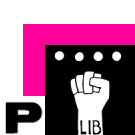T4PP: Difference between revisions
Andre Castro (talk | contribs) No edit summary |
Andre Castro (talk | contribs) |
||
| Line 2: | Line 2: | ||
=03 Templates Text & Bots= | =03 Templates Text & Bots= | ||
* [[templates]] - generating text and visual material from templates | |||
* [[twitter bot]] - create a twitter bot that post regularly | * [[twitter bot]] - create a twitter bot that post regularly | ||
=02_UNIX and Scriptable workflows = | =02_UNIX and Scriptable workflows = | ||
Revision as of 12:12, 18 November 2016
Tools 4 Procedural Publishing
03 Templates Text & Bots
- templates - generating text and visual material from templates
- twitter bot - create a twitter bot that post regularly
02_UNIX and Scriptable workflows
Resources:
- Reader PDF File:T4PP Reader 01.pdf
- Shell Scripting Tutorial http://www.shellscript.sh/
- Unix Shell Scripting Tutorial http://supportweb.cs.bham.ac.uk/docs/tutorials/docsystem/build/tutorials/unixscripting/unixscripting.html
Recipes in creating PDF from HTML & Markdown files
RECIPIE NOEMIE-GIULIA-CLAUDIA
- We create a pdf from html
- We start customising it (style.css ++ making patterns out of characters)
- convert it with latex
- changing the characters : command sed
sed 's/snow-white/sun-black/g' snowwhite.txt
- write the classes css / style.css:
wget http://anjagroten.com/ mv "index.html" "anja.html" pandoc anja.html -f html -t markdown -s -o anja.md sed "s/a/ @ <\/span>/g" anja.md > anjaChanged.md pandoc anjaChanged.md -f markdown -t html -s -o anjaChanged.html touch style.css echo ".a{color-background:red; color: white; font-size:30pt; font-family:Helvetica;}" >> style.css weasyprint anjaChanged.html -s style.css final.pdf
Margreet & Kimmy - from multiple Markdown files to PDF using Weasyprint
- step 1: copy all files to shared folderS
scp Path/yourFile.md user@IP:/home/margreet/
(from the terminal of your own computer, not from the server)
- step 2: find all .md files and copy it to a folder
find markdown files: find . -type f -name *.md
full command to find md files and copy to a folder:
find . -type f -name *.md -exec cp {} ../files/ \;
- step 3: change filenames to create a particular order of the files so when we make 1 file they have this order
mv "* Scarcity of attention.md" 01_Attention_Franc.md
etc.
- Step 4: Make one long file of seperate Markdown files
cat 0*.md > Issue_One_Scarcity.md
- Step 5: Check in html
pandoc -f markdown -t html -s -o Issue_One_Scarcity.md
- Step 6: Create a style CSS
created a CSS locally and moved from the local place to the specific folder we are working in
- Step 7: Convert to PDF with weasyprint
weasyprint SpecialIssueScarcity.html -s scarcity_style.css Test_01.pdf
OUR CSS: http://pzwart1.wdka.hro.nl/~margreet/weasyprint/files/scarcity_style.css
Result http://pzwart1.wdka.hro.nl/~margreet/weasyprint/files/Test_01.pdf
01_Publishing on the World Wide Web
In this first session we'll focus on how publish on the World Wide Web.
We'll get familiar with simple tools such as HTML and CSS, which constitute the basis of any website.
Jointly we'll investigate how, before the arrival of Web 2.0 social media platforms, publishing on the Web was a DIY activity, which resulted in an explosion of form and content put out in the form of homepages for the world to see.
By 2016 many of these have left the Web, specially after Geocities - probably the largest website hosting service - was acquired by Yahoo and shutdown in October 26, 2009. However, thanks to the efforts of archiving efforts from Archive Team and others, many of the Geocities hosted web pages can still be browsed today.
As a an outcome of this 2-day session I propose the collaborative development of a website charting the history and existence of Geocities, using HTML and CSS. The result can be anything from a time-line, a map, or travel guide through the formers territories of Geocities.
- T4PP PAD https://pad.pzimediadesign.nl/p/xpub-t4pp-01
- HTML
- CSS
- http://pzwart1.wdka.hro.nl/~t4pp/ directory listing
